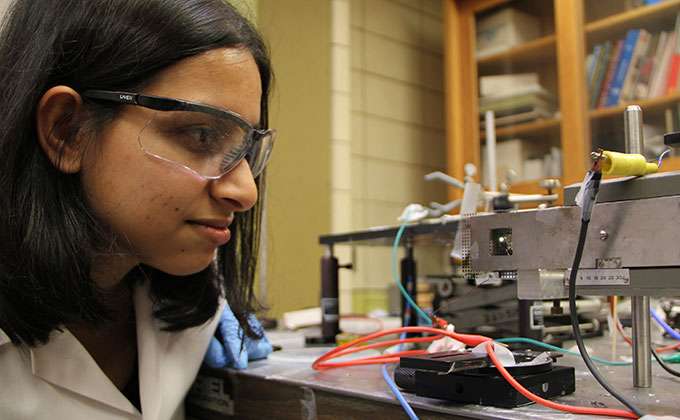Scientists create an all-organic UV on-chip spectrometer

The U.S. Department of Energy's Ames Laboratory has developed a near ultra-violet and all-organic light emitting diode (OLED) that can be used as an on-chip photosensor.
It's a first in a rather specialized field of research to capture and manipulate light near the invisible end of the spectrum, around 400 nm in wavelength.
"The real pie in the sky goal is a tiny chip that is a whole spectrometer, so it can measure the absorption or luminescence spectrum of anything that can absorb or emit light. This is a step in that direction," said Ames Laboratory scientist Joseph Shinar.
While there has been high interest in visible OLEDs as alternatives to conventional LEDs in widely-used applications such as consumer electronics, there has been much less investigation into OLEDs in the ultra-violet spectrum. "And that has failed to address a rising demand of small-size, flexible devices for analytical applications," explained Ames Laboratory associate Ruth Shinar, a scientist at Iowa State University's Microelectronics Research Center.
"Such devices can be used for detection in food safety, water quality, medical diagnosis and other fields where biosensing is necessary. They can be hand-held, used in the field, and potentially inexpensive and disposable."
The researchers' work exploits the effects of optical microcavities, which are structures formed by the reflective surfaces on either side of an optical medium. The small size of microcavities alters the behavior of light wavelengths. These altered characteristics allow UV OLEDs with narrower emission spectra to be tuned to specific wavelength emissions for sensing and optical excitation. When an array of such OLEDs is created, multiple analyses and optical excitations can be performed on the same device.
Building on previous Ames Laboratory microcavity OLED research, the researchers created a device that could emit light in the wavelength range of 370 to 430 nm, the deep blue and near-ultraviolet, expanding previous developments in the visible range. Graduate student Eeshita Manna performed the experimental work and Ames Laboratory scientist Rana Biswas simulated the spectra. In further research performed by former graduate student Emily Hellerich, they extended the range to 470 nm by using a unique combination of two photoactive polymers, CBP and PVK. Combined with an earlier study on visible microcavity OLED arrays, they can now cover the 370 to 640 nm range.
More information: Eeshita Manna et al. Tunable Near UV Microcavity OLED Arrays: Characterization and Analytical Applications, Advanced Functional Materials (2015). DOI: 10.1002/adfm.201403313
Emily S. Hellerich et al. Deep blue/ultraviolet microcavity OLEDs based on solution-processed PVK:CBP blends, Organic Electronics (2015). DOI: 10.1016/j.orgel.2015.05.041
Journal information: Advanced Functional Materials
Provided by Ames Laboratory




















